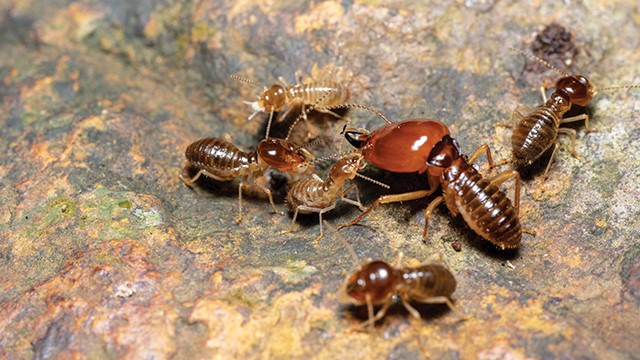- Head Office : Ruko Apartemen Serpong Green View RK3, RT01/03, Jl. Lengkong Gudang Timur Raya, Serpong, Tangerang Selatan

Termites in Indonesia are a common pest, but not many people understand them, especially the latest methods for handling them. Termite control has significantly evolved in recent years, with many pest control companies using bait systems rather than traditional insecticide sprays. This article aims to help consumers understand these different approaches to make more informed decisions about termite control.
a. Subterranean Termites
Subterranean termites are a common type of termite found in Indonesia and many other regions. These termites live underground in cooperative colonies that interconnect through subterranean tunnels. These decentralized colonies occupy multiple nesting and feeding sites connected by underground tunnels. Termite colonies can be very large, consisting of hundreds of thousands to millions of individuals, covering areas up to half a hectare. In residential settings, the colony responsible for the damage may be located in a neighbor’s yard rather than around or beneath the infested house.
Subterranean termites dig winding tunnels in the soil that eventually lead them to wood, their primary food source. In nature, termites help decompose organic matter and return nutrients to the soil. However, they sometimes feed within buildings and find wood or wood products (paper, cardboard, etc.). Once they discover a suitable food source, worker termites create invisible scent trails to attract and guide other colony members into the building. Termite infestations can go undetected for years, hidden behind walls, floors, and barriers. This requires a more modern and effective approach to prevent and manage termite attacks, especially subterranean termites.
b. Barrier Treatment
Barrier treatment, also known as soil injection, is a traditional approach to controlling subterranean termites by applying a liquid pesticide known as a 'termiteicide' around and beneath a building. The goal is to create a long-lasting chemical 'barrier' in the soil to prevent termites from entering and infesting the structure. Termites attempting to penetrate the treated soil will be killed or repelled, while termites already inside will also die. Research has shown that barrier products that are both termite-resistant and lethal are generally the most reliable. Examples include fipronil, imidacloprid, and chlorantraniliprole. Although this treatment is usually effective, large volumes of termiteicide are applied around the building, often involving drilling/injection through adjacent yards and patios. Some homeowners find this termiteicide injection process impractical and disruptive.
Barrier treatment application at a home
c. Termite Baiting System
The termite baiting system uses a very different approach. Bait systems use attractants and slow-acting active ingredients distributed like 'smart missiles' that termites consume to incapacitate foraging termite populations inside and around the home. Termites eat the bait and share it with the colony in their nest, causing the termite numbers to gradually decrease. A comprehensive baiting program aims to maintain a termite-free condition on the customer’s property through ongoing inspections, monitoring, and re-baiting as needed.
Termite Baiting System
Termite baits consist of cellulose (wood's structural component) combined with a slow-acting insecticide that disrupts normal termite growth processes. Within weeks of consuming the bait, termites will die while attempting to molt. This delayed action is crucial; if the bait kills termites quickly, sick or dead termites may accumulate near the bait station, increasing the likelihood that other termites in the area will avoid it. The delay also enhances the spread of the lethal material to nesting partners, including termites that have never consumed the bait. This method can eliminate the entire colony.